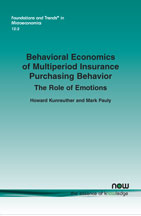Behavioral Economics of Multiperiod Insurance Purchasing Behavior: The Role of Emotions
By Howard Kunreuther, University of Pennsylvania, USA, kunreuth@wharton.upenn.edu | Mark Pauly, University of Pennsylvania, USA, pauly@wharton.upenn.edu
Abstract
Consumers face many risky situations that can severely impact their wealth or health from one year to the next. People sometimes behave in inconsistent ways in such settings; many individuals faced with these risks do not consider purchasing insurance until after suffering a loss, but then they may cancel their policy a few years later if they have not had a claim (Kunreuther, Pauly, and McMorrow 2013). Our interest is in why a consumer, having decided whether or not to purchase insurance for a particular year, might change that decision over time – even if the person’s risk and insurance premium remain exactly the same every year in the future. In some circumstances (fire insurance, life insurance), many people renew their policies year after year in ways consistent with relevant tradeoffs that consider the likelihood and consequences of a particular risk in relation to the cost of the insurance. If these individuals make decisions systematically, they should not change their insurance decision over time if the probability, the premiums, and the consequences from the risk remain the same from year to year. However, we find that a significant number of people are swayed by their emotions and past experiences when making their future insurance decisions. This behavior is particularly common for risks that are classified as low-probability, high-consequence (LP-HC) events. Because consumers’ knowledge is incomplete, ambiguous, and biased by recent experience, they may rely on their intuition to decide whether to buy, keep, drop, or change the extent of their insurance coverage. Potential buyers may not face an identical set of circumstances year after year. Loss probabilities may change over time (for example, due to global warming, build-up of earthquake stresses, or onset of a chronic health condition). Buyers may be confused about whether experiencing a major loss tells them something about future probabilities, even if they are explicitly informed as to the potential damage from a future low probability event. Having suffered a personal loss may affect how the person feels about next year’s coverage. The interplay between changing expectations about next period’s risk and willingness to buy insurance can, in theory and in practice, affect buyer behavior in many different ways.
Behavioral Economics of Multiperiod Insurance Purchasing Behavior: The Role of Emotions
Behavioral Economics of Multiperiod Insurance Purchasing Behavior addresses the question of how potential insurance buyers make decisions like these by considering the conceptual and empirical evidence that address the following theoretical and behavioral issues: the extent that consumers tend to follow the multiperiod decision rules based on expected utility [E(U)] maximization; and the factors that influence their choices when they do not behave as if they are maximizing E(U).
The principal contribution of this monograph is to demonstrate that emotions play a role in predicting departures from expected utility maximization for making insurance purchasing decisions over time. The authors highlight the conceptual issues and alternative theories of behavior about repeat insurance purchasing over time and the empirical literature on the proportion of consumers that buy coverage after loss-producing events only to cancel their insurance as those events become more distant in time. The monograph then details the findings from novel web-based experiments that seek to determine whether people change their insurance decisions after experiencing a loss when offered a relatively high, medium or low premium relative to the expected loss.
Section 2 reviews the empirical evidence on deviations from rational thinking, especially as they relate to choices about repeated purchase over time. It also discusses the interplay between cognitive biases generated by intuitive thinking and emotions in changing insurance purchase decisions over time. Section 3 details an experiment in the context of hypothetical hurricane damage where individuals are told that loss probabilities and premiums remain the same from period to period. Section 4 details an experiment where participants must choose between high-deductible health insurance at a given premium and low-deductible health insurance at a higher premium, and explores whether they will switch from one policy to the other over time. Section 5 draws together the findings, and provides guiding principles of insurance and recommendations for public-private partnerships to address the cognitive biases noted in Section 2 via a behavioral risk audit that encourages more deliberative thinking with respect to insurance-related choices.
